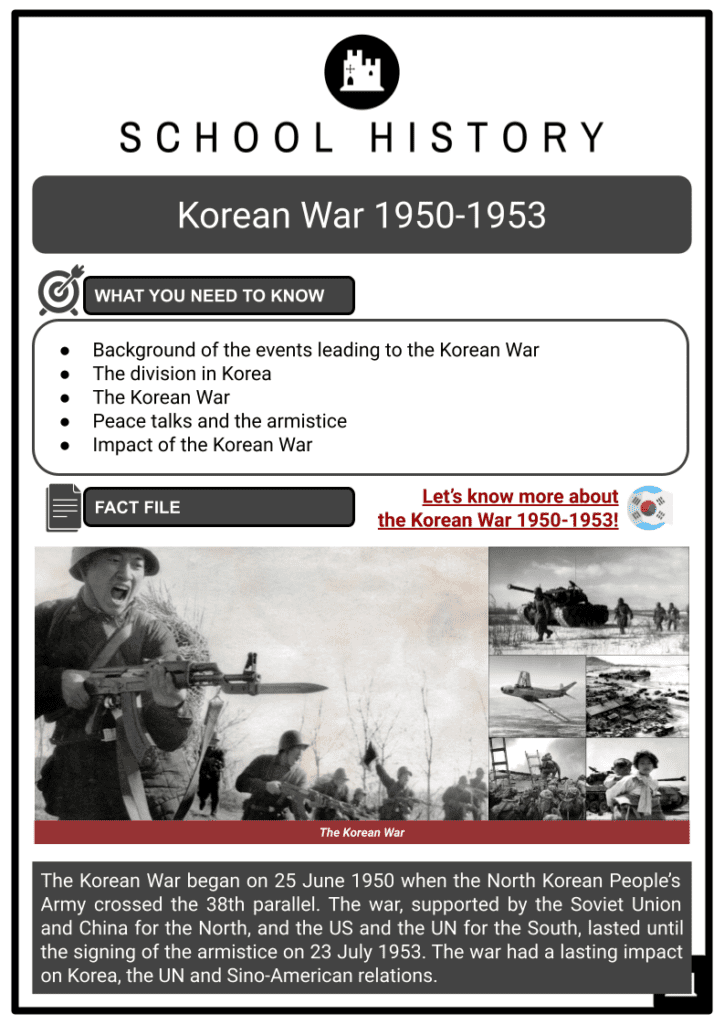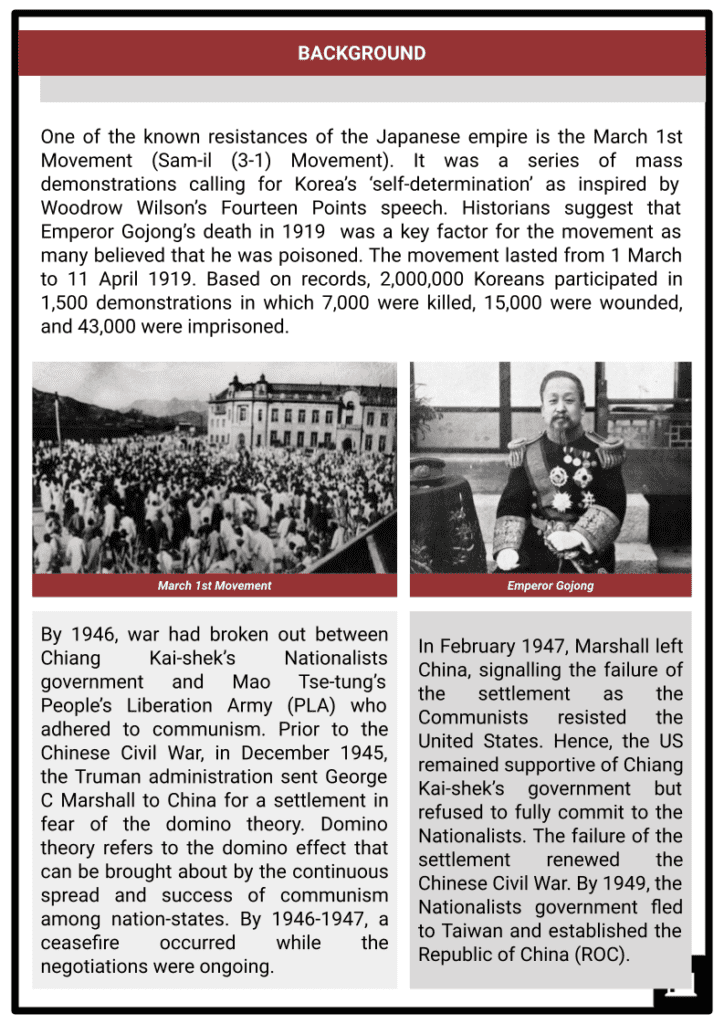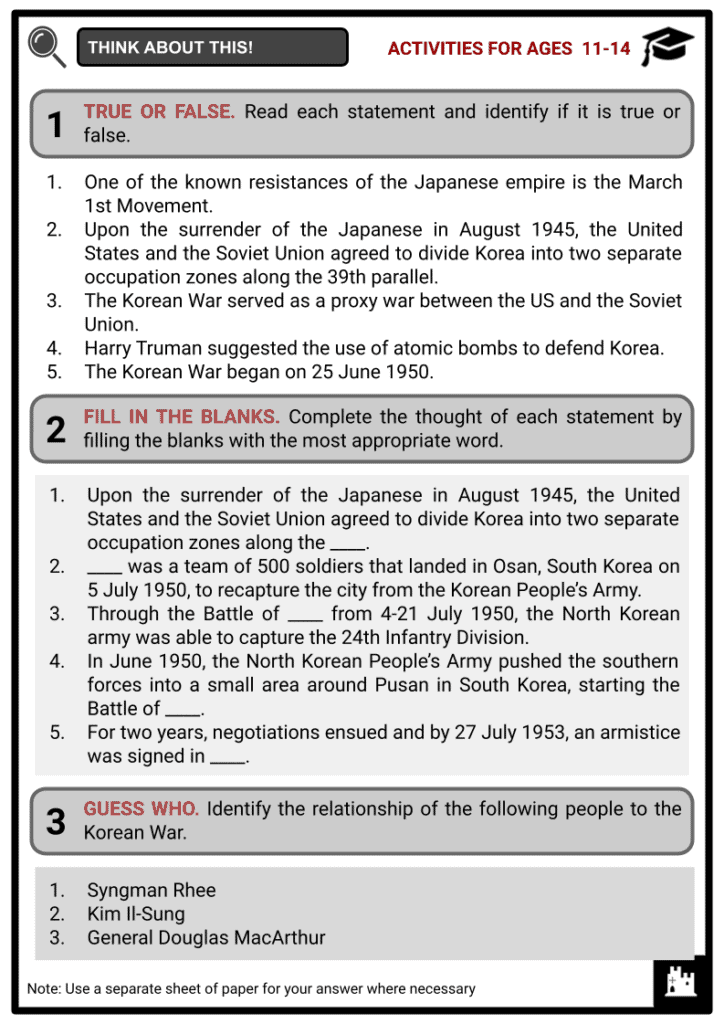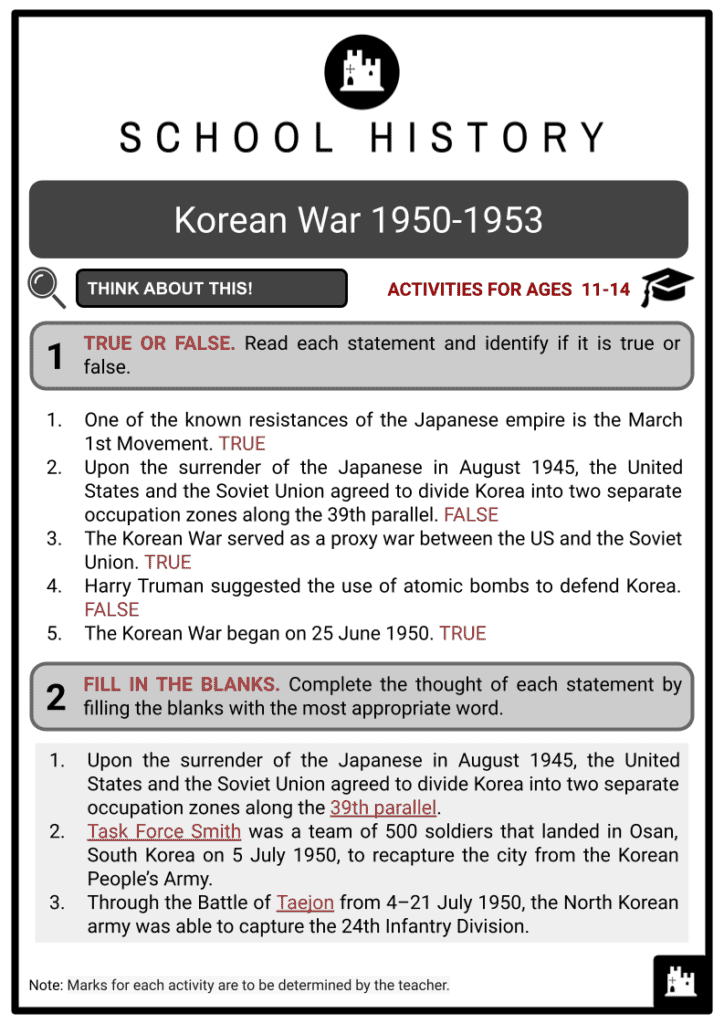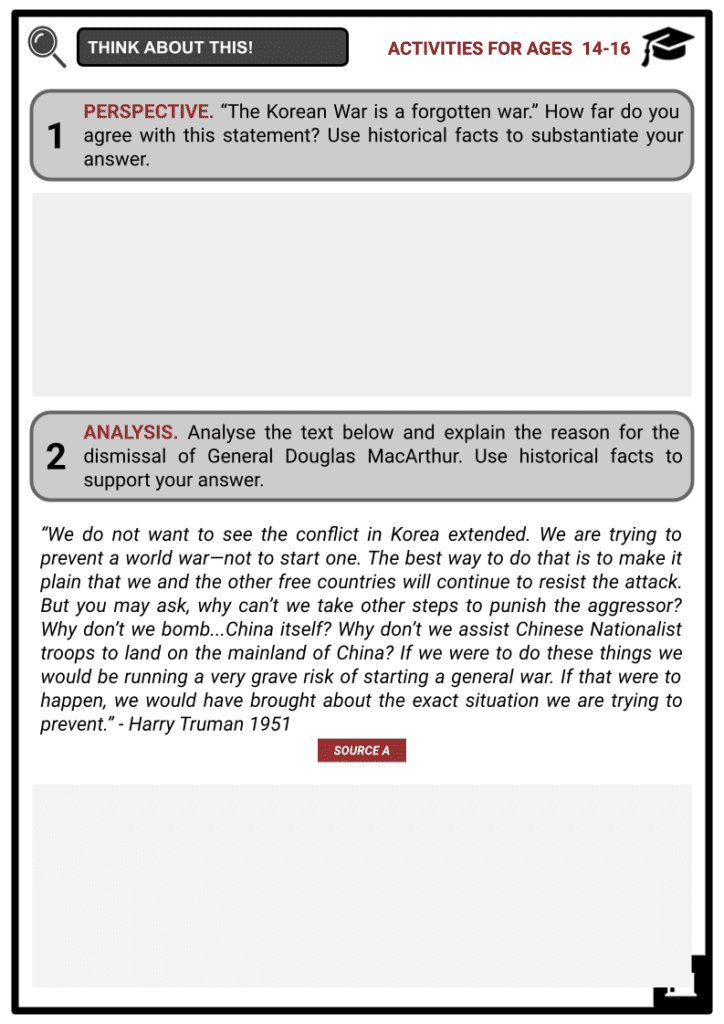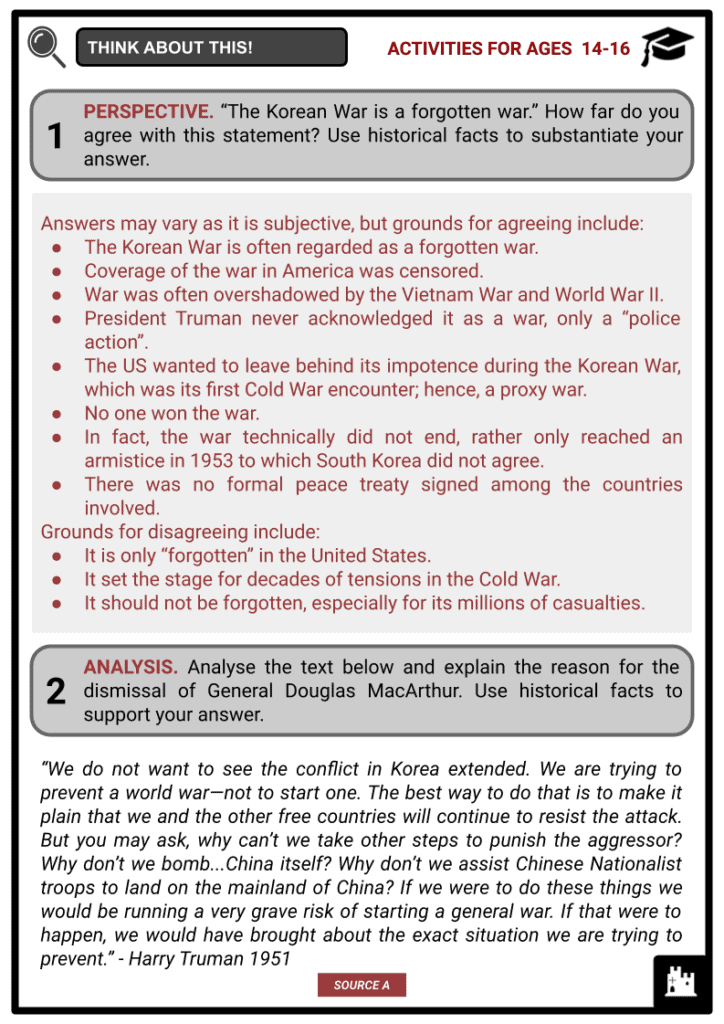Download Korean War 1950-1953 Worksheets
Do you want to save dozens of hours in time? Get your evenings and weekends back? Be able to teach about the Korean War 1950-1953 to your students?
Our worksheet bundle includes a fact file and printable worksheets and student activities. Perfect for both the classroom and homeschooling!
Summary
- Background of the events leading to the Korean War
- The division in Korea
- The Korean War
- Peace talks and the armistice
- Impact of the Korean War
Key Facts And Information
Let’s find out more about the Korean War 1950-1953!
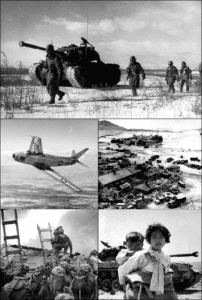
The Korean War began on 25 June 1950 when the North Korean People’s Army crossed the 38th parallel. The war, supported by the Soviet Union and China for the North, and the US and the UN for the South, lasted until the signing of the armistice on 23 July 1953. The war had a lasting impact on Korea, the UN and Sino-American relations.
Background
- One of the known resistances of the Japanese empire is the March 1st Movement (Sam-il (3-1) Movement). It was a series of mass demonstrations calling for Korea’s ‘self-determination’ as inspired by Woodrow Wilson’s Fourteen Points speech. Historians suggest that Emperor Gojong’s death in 1919 was a key factor for the movement as many believed that he was poisoned. The movement lasted from 1 March to 11 April 1919. Based on records, 2,000,000 Koreans participated in 1,500 demonstrations in which 7,000 were killed, 15,000 were wounded, and 43,000 were imprisoned.
- By 1946, war had broken out between Chiang Kai-shek’s Nationalists government and Mao Tse-tung’s People’s Liberation Army (PLA) who adhered to communism. Prior to the Chinese Civil War, in December 1945, the Truman administration sent George C Marshall to China for a settlement in fear of the domino theory. Domino theory refers to the domino effect that can be brought about by the continuous spread and success of communism among nation-states. By 1946-1947, a ceasefire occurred while the negotiations were ongoing.
- In February 1947, Marshall left China, signalling the failure of the settlement as the Communists resisted the United States. Hence, the US remained supportive of Chiang Kai-shek’s government but refused to fully commit to the Nationalists. The failure of the settlement renewed the Chinese Civil War. By 1949, the Nationalists government fled to Taiwan and established the Republic of China (ROC).
The Division of Korea
Upon the surrender of the Japanese in August 1945, the United States and the Soviet Union agreed to divide Korea into two separate occupation zones along the 38th parallel.
-
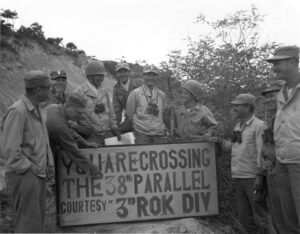
The 38th Parallel The original plan was to reunify Korea under an independent government by holding a national election after a five-year trusteeship. However, US-Soviet relations continued to deteriorate. Eventually, two governments emerged in Korea: the communists in the North and the anti-communists in the South.
- On 17 July 1948, the South Korean government established and promulgated a constitution. Syngman Rhee was elected president on 20 July 1948. Through this, the Republic of Korea was established on 15 August 1948. On the other hand, in the North, the Soviet Union established a communist government led by Kim Il-Sung.
- Kim Il-Sung (15 April 1912 – 8 July 1994) was the first leader of North Korea and served as the state’s head from its establishment in 1948 until his death in 1994. Prior to this, he served as a communist guerilla and was a supporter of the Communist Party of China. Hence, when he became the country’s leader, he established political and economic policies adhering to the ideology of communism. In 1998, he was declared the Eternal President of the Republic.
- Syngman Rhee (26 March 1875 – 19 July 1965) was the first and last head of the Provisional Government of the Republic of Korea. By 20 July 1948, he was elected as the first president of the Republic of Korea and served until 1960. His administration led South Korea during the Korean War.
- As an anti-communist, he ordered killings of suspected communists during the Korean War. Following a 1960 electoral issue, he went into exile in Honolulu, Hawaii.
Korean War
- In the aftermath of the Chinese Civil War, with the successful establishment of the People’s Republic of China, the Chinese government rewarded North Koreans who assisted them in Manchuria by sending home North Korean veterans along with their weapons. Furthermore, they promised North Korea that in case of a war against the South, they would assist them.
- Kim Il-Sung believed that the South Korean Army was weaker than the Korean People’s Army (KPA). Hence, by March 1949, he sought the approval of Joseph Stalin to invade South Korea. Initially, Stalin did not approve this suggestion, but by April 1950, he confirmed that an invasion could take place on the condition that China would eventually assist the North Koreans. On 25 June 1950, the KPA crossed the 38th parallel armed with tanks and heavy artillery. By 27 June, Syngman Rhee fled from Seoul.
- The South Korean Army responded by blowing up the Hangang Bridge in order to stop the KPA advancing. At that time, thousands of refugees were crossing the bridge, which resulted in hundreds of deaths. South Korea suffered heavily from the invasion and several members of the South Korean National Assembly pledged allegiance to the North Korean government.
- In July 1950, the Truman administration ordered the deployment of US naval and aerial forces to assist South Korea, fearing a communist takeover. Furthermore, the US government sought help from the United Nations Security Council to send UN troops to the country.
- The UN-supported this request as the Soviet Union was avoiding the Security Council over the fact that the UN had admitted Taiwan as a delegate of the organisation. Had the Soviet Union been present, they would have vetoed the request of the US government. By September 1950, General Douglas MacArthur and UN troops marched across the 38th parallel to resist the North Korean army.
- The US and the UN justified their military campaign as they feared a repeat of the actions of Hitler, Mussolini and the Japanese empire. By August 1950, the US Congress approved the appropriation of $12 billion for its military action in Korea, which faced extensive budget restrictions but could produce a strong conventional army.
-
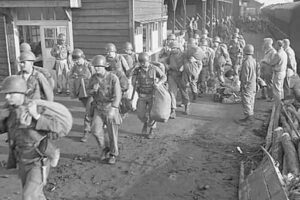
Task Force Smith In September 1950, General Douglas MacArthur and UN troops crossed the 38th parallel to resist the North Korean army. Fearing retaliation from neighbouring China, the Truman administration immediately sent the US Seventh Fleet to the Taiwan Strait to defend the non-communist Chinese government. The US then regarded the Nationalist government of Taiwan as the only legal representative of China and isolated communist China for more than two decades.
- The first engagement of the US with the KPA was Task Force Smith. On 5 July 1950, a team of 500 soldiers landed in Osan, South Korea, to recapture the city from the KPA. The army was unsuccessful, resulting in 180 deaths. The KPA then advanced, pushing US troops back from Chochiwon, Chonan and Pyeongtaek into Taejon.
- Through the Battle of Taejon from 4-21 July 1950, the North Korean army was able to capture the 24th Infantry Division, which suffered from an estimated 3,000 deaths and the capture of its commander, Major General William F Dean.
- In June 1950, the North Korean People’s Army pushed the southern forces into a small area around Pusan in South Korea. In between the Battle of Pusan Perimeter from 4 August to 18 September 1950, MacArthur and his troops were able to launch an amphibious assault in Incheon, which pushed the North Koreans across the 38th parallel back into their territory. The North Korean army was heavily defeated in the Battle of Incheon as they were also engaged in the Battle of Pusan Perimeter.
- The southern forces were successful in defeating the North Korean army. Pusan became one of the major ports used by the UN and the US for sending in troops, tanks and military artillery. On 25 September 1950, the southern forces were able to recapture Seoul from the North Korean army.
- Harry Truman feared that the US-backed troops of the United Nations could trigger a Chinese invasion once they reached the Yalu River border between North Korea and China. MacArthur assured Truman that the Chinese would not retaliate. On 30 September 1950, Zhou Enlai, the Premier of the People’s Republic of China, warned the United States that if the US and the UN troops crossed the 38th Parallel, China would intervene.
- Following the Battle of Incheon, by October, the North Korean army was pushed back to the 38th parallel on the Yalu River. In November 1950, Chinese volunteer forces intervened on behalf of North Korea and eventually drove UN troops below the 38th parallel. This action was spurred on by Mao Tse-tung’s intentions to spread communism in Asia and its defiance over US intervention.
- General Douglas MacArthur suggested the use of atomic bombs to defend Korea. Truman rejected the idea as it would cause senseless civilian deaths. In a letter, MacArthur remarked that “there is no substitute for victory” in fighting international communism. Hence, on 11 April 1951, MacArthur was removed from his post. Truman justified the move as insubordination since MacArthur had not followed orders regarding the 38th parallel. The letter sent by MacArthur was considered the last straw.
Peace Talks and the Armistice
- In June 1951, additional UN troops were deployed to Korea. Eventually, the communists were driven back above the 38th Parallel. At this point, the war became a stalemate. In July 1951, Truman and his new military commanders began to conduct peace talks in Panmunjom, North Korea. The fighting continued while negotiations were underway.
-
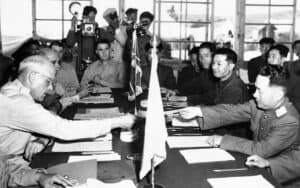
Korean War Armistice Both sides agreed on the maintenance of the 38th Parallel as the boundary between the North and the South. However, differences arose regarding prisoners of war. While China and North Korea approved forced repatriation, the US disagreed. In November 1952, Truman was replaced by Dwight D Eisenhower. He promised the Korean War would end and he would go to the country to witness it personally.
- For two years, negotiations ensued, and by 27 July 1953, an armistice was signed in Panmunjom. The POWs could remain where they wanted and a new boundary near the 38th parallel was drawn, giving South Korea an additional 1,500 square miles of territory. Furthermore, a 2.5-mile-wide ‘demilitarized zone’ was established.
Impact of the Korean War
- Proxy War: The Korean War served as a proxy war between the US and the Soviet Union. Proxy wars became a significant aspect adding to the tension between the East and the West as the Korean War was later followed by the Vietnam War.
- Demilitarized Zone: The demilitarized zone placed near the 38th parallel was a symbol of the armistice and the policy of containment. The area served as the border between North Korea and South Korea.
- US Military Troops: US troops remained stationed in South Korea. This gesture irritated the Chinese government adding to the tension between the US and China.
- Sino-American Relations: The arrival of the US Seventh Fleet in the Taiwan Strait to defend the state from the communist government of China increased the tension between the two superpowers. The US government regarded Taiwan as the only legal representative of the Chinese people and isolated the People’s Republic of China for more than two decades.
- An estimated 5 million people died during the Korean War. Around 50% were civilians, which is comparatively higher than the Second World War and the Vietnam War. Around 40,000 Americans died in the war and 100,000 were wounded.
Image sources
- https://upload.wikimedia.org/wikipedia/commons/c/ca/Korean_War_Montage_2.png
- http://www.endofempire.asia/wp-content/uploads/2015/08/downloadfiles0812.5.jpg
- http://www.koreanwaronline.com/arms/KWjpg/TFSmith.jpg
- https://www.navalhistory.org/wp-content/uploads/2018/07/Associated-Press-Korean-War-Armistice-1005x630.jpg

